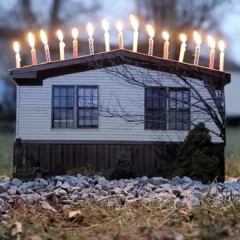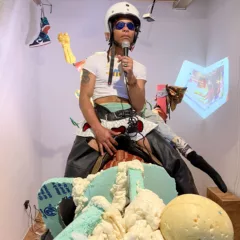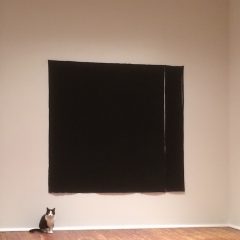“Poseur” at Grizzly Grizzly brings together two artists, Brian Hubble and Eric Ashcraft, whose combined approach to minimalism involves found objects and a good deal of scrutiny. The artists’ shared premise is that the longer you work with an object, the more it starts to take on other dimensions and possibilities. Appropriate to the theme of scrutiny, there is a staring contest, a battle of the wills that can either be tense or humorous, that is central to the show.
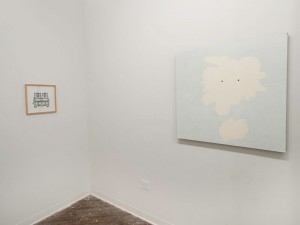
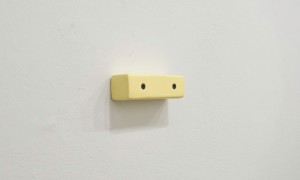
Ashcraft’s “Staring Contest,” a painting that hints at a sky, but something else too when you look at it longer, sits diagonally across the room from his “Certainty, Safety, Stability,” the show’s standout piece. At first “Certainly” is so inconspicuous you’re not even sure it’s part of the exhibition without looking at it on the exhibition sheet. It’s nothing but a piece of varnished wood with two screws in it. When you finally take notice and examine it more closely, you start to see it strangely, the way your own name on a page begins to look foreign after staring at it for a minute. Then, sure enough, the screws start to resemble eyes, and then it occurs to you that it’s the counterpart to “Staring Contest” across the room.
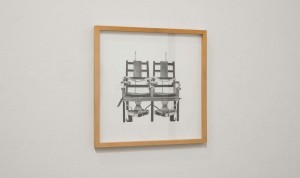
Hubble’s “Electric Love Seat (or Love Destroyer) catches your eye when you walk in. A drawing of twin electric chairs, it’s a signifier of self-awareness and keeping egos in check. That there’s two chairs suggests, among other things, that Hubble and Ashcraft act as a kind of buddy system for one another, guarding one another from getting lost in pretense.

The show’s title is a reference to the mutability of objects and also a sly way of letting viewers know the artists are aware of their own mutability. Of the two, Ashcraft is more overtly concerned with transformation and mutability. His objects, arranged around the room, are made from a variety of materials. A native Montanan, Ashcraft uses his objects as an expression of that state’s landscape and atmosphere. Ashcraft’s “Where’s My Flying Car?” a triangular light beaming from the center of an abandoned cushion harks back to James Turrell’s “Skyspace.” Where Turrell’s harnessing of light transports viewers to a divine place, Ashcraft’s uses artificial light emanating from something utterly mundane — that nonetheless begins to look truly revelatory if you stand in front of it long enough.
The exhibition was designed with the inclusion of a collaborative piece. By “collaborative,” however, Hubble and Ashcraft went for a looser definition: They asked James Powers to contribute something. His sheet of fiberglass (“Untitled”) sits high up on the wall next to “Certainty, Safety, Stability,” like a dirty, opaque window.
Call it “artistic intentional creep,” what “Poseur” captures is what happens when you engage in a staring contest, and things emerge from that intense concentration that you didn’t – or couldn’t – see before.
“Poseur” is at Grizzly Grizzly through Saturday, Sept. 29. Photos by Jaime Alvarez courtesy of Grizzly Grizzly. More photos here.


